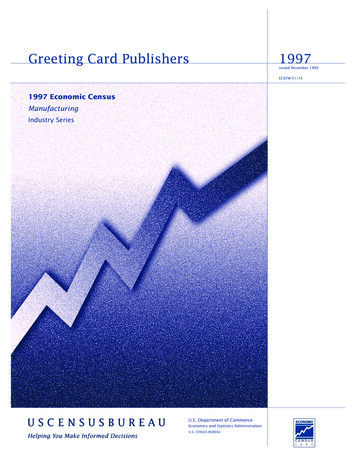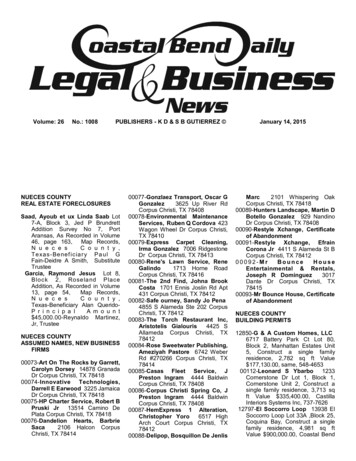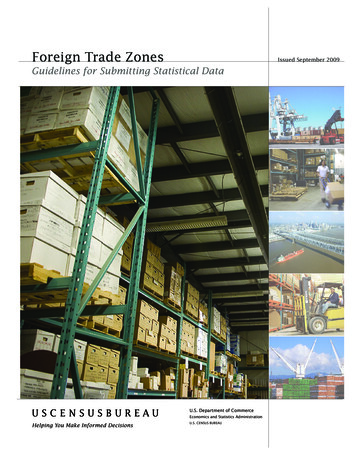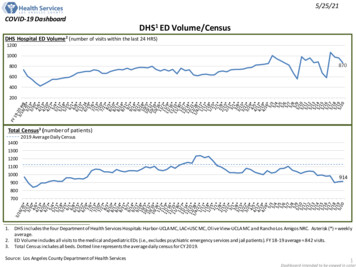
Transcription
Greeting Card Publishers1997Issued November 1999EC97M-5111E1997 Economic CensusManufacturingIndustry SeriesU.S. Department of CommerceEconomics and Statistics AdministrationU.S. CENSUS BUREAU
ACKNOWLEDGMENTSThe staff of the Manufacturing and Construction Division prepared this report.Judy M. Dodds, Assistant Chief for Census and Related Programs, was responsible for the overall planning, management, and coordination. KennethHansen, Chief, Manufactured DurablesBranch, assisted by Mike Brown, ReneeColey, Raphael Corrado, and MilbrenThomas, Section Chiefs, Michael Zampogna, Former Chief, Manufactured Nondurables Branch, assisted by Allen Foreman, Robert Miller, Robert Reinard,and Nat Shelton, Section Chiefs, and TomLee, Robert Rosati, and Tom Flood,Special Assistants, performed the planningand implementation. Stephanie Angel,Brian Appert, Stanis Batton, Carol Beasley, Chris Blackburn, Larry Blumberg, Vera Harris-Bourne, BrendaCampbell, Suzanne Conard, VanceDavis, Mary Ellickson, Matt Gaines,Merry Glascoe, Kay Hanks, KarenHarshbarger, Nancy Higgins, JamesHinckley, Walter Hunter, Jim Jamski,Evelyn Jordan, Robert Lee, John Linehan, Paul Marck, Keith McKenzie,Philippe Morris, Joanna Nguyen, BettyPannell, Joyce Pomeroy, Venita Powell,Cynthia Ramsey, Chris Savage,Aronda Stovall, Sue Sundermann, Thanos Theodoropoulos, Dora Thomas,Ann Truffa, Ronanne Vinson, KeeleyVoor, Denneth Wallace, Tempie Whittington, Lissene Witt, and MikeYamaner provided primary staff assistance.Brian Greenberg, Assistant Chief forResearch and Methodology Programs,assisted by Stacey Cole, Chief, Manufacturing Programs Methodology Branch, andRobert Struble, Section Chief, providedthe mathematical and statistical techniques as well as the coverage operations.Jeffrey Dalzell and Cathy Ritenour provided primary staff assistance.Mendel D. Gayle, Chief, Forms, Publications, and Customer Services Branch,assisted by Julius Smith Jr. and BarutiTaylor, Section Chiefs, performed overallcoordination of the publication process.Kim Credito, Patrick Duck, ChipMurph, Wanda Sledd, and VeronicaWhite provided primary staff assistance.The Economic Planning and CoordinationDivision, Lawrence A. Blum, AssistantChief for Collection Activities and ShirinA. Ahmed, Assistant Chief for PostCollection Processing, assisted by DennisShoemaker, Chief, Post-Collection CensusProcessing Branch, Brandy Yarbrough,Section Chief, Sheila Proudfoot, RichardWilliamson, Andrew W. Hait, and Jennifer E. Lins, was responsible for developing the systems and procedures for datacollection, editing, review, correction anddisseminationThe staff of the National Processing Center,Judith N. Petty, Chief, performed mailoutpreparation and receipt operations, clericaland analytical review activities, data keying, and geocoding review.The Geography Division staff developedgeographic coding procedures and associated computer programs.The Economic Statistical Methods and Programming Division, Charles P. PautlerJr., Chief, developed and coordinated thecomputer processing systems. Martin S.Harahush, Assistant Chief for Quinquennial Programs, assisted by Barbara Lambert and Christina Arledge were responsible for design and implementation of thecomputer systems. Gary T. Sheridan,Chief, Manufacturing and ConstructionBranch, Lori A. Guido and Roy A. Smith,Section Chiefs, supervised the preparationof the computer programs.Computer Services Division, Debra Williams, Chief, performed the computer processing.The staff of the Administrative and Customer Services Division, Walter C. Odom,Chief, performed planning, design, composition, editorial review, and printing planning and procurement for publications,Internet products, and report forms.Cynthia G. Brooks provided publicationcoordination and editing.
Greeting Card Publishers1997Issued November 1999EC97M-5111E1997 Economic CensusManufacturingIndustry SeriesU.S. Department of CommerceWilliam M. Daley,SecretaryRobert L. Mallett,Deputy SecretaryEconomicsand StatisticsAdministrationRobert J. Shapiro,Under Secretary forEconomic AffairsU.S. CENSUS BUREAUKenneth Prewitt,Director
ECONOMICSAND STATISTICSADMINISTRATIONEconomicsand StatisticsAdministrationRobert J. Shapiro,Under Secretaryfor Economic AffairsU.S. CENSUS BUREAUKenneth Prewitt,DirectorWilliam G. Barron,Deputy DirectorPaula J. Schneider,Principal Associate Directorfor ProgramsFrederick T. Knickerbocker,Associate Directorfor Economic ProgramsThomas L. Mesenbourg,Assistant Directorfor Economic ProgramsWilliam G. Bostic Jr.,Chief, Manufacturingand Construction Division
CONTENTSIntroduction to the Economic Census .Manufacturing .15TABLES1.2.3.4.5.6a.6b.7.Industry Statistics on NAICS Basis With Distribution Among1987 SIC Based Industries: 1997 .Industry Statistics for Selected States: 1997 .Detailed Statistics by Industry: 1997 .Industry Statistics by Employment Size: 1997.Industry Statistics by Industry and Primary Product ClassSpecialization: 1997 .Products Statistics: 1997 and 1992 .Product Class Shipments for Selected States: 1997 and 1992 .Materials Consumed by Kind: 1997 and 1992.7789910 10APPENDIXESA.B.C.D.E.F.G.Explanation of Terms .NAICS Codes, Titles, and Descriptions .Coverage and Methodology.Geographic Notes .Metropolitan Areas .Footnotes for Products Statistics and Materials Consumed byKind .Comparability of Product Classes and Product Codes: 1997 to1992 . G–1Not applicable for this report.MANUFACTURINGmINDUSTRY SERIESU.S. Census Bureau, 1997 Economic CensusA–1B–1C–1 Nov. 4, 1999NAICS 511191iii
Introduction to the Economic CensusPURPOSES AND USES OF THE ECONOMIC CENSUSThe economic census is the major source of facts aboutthe structure and functioning of the Nation’s economy. Itprovides essential information for government, business,industry, and the general public. Title 13 of the UnitedStates Code (Sections 131, 191, and 224) directs the Census Bureau to take the economic census every 5 years,covering years ending in 2 and 7.The economic census furnishes an important part of theframework for such composite measures as the grossdomestic product estimates, input/output measures, production and price indexes, and other statistical series thatmeasure short-term changes in economic conditions. Specific uses of economic census data include the following: Policymaking agencies of the Federal Government usethe data to monitor economic activity and assess theeffectiveness of policies. State and local governments use the data to assessbusiness activities and tax bases within their jurisdictions and to develop programs to attract business. Trade associations study trends in their own and competing industries, which allows them to keep their members informed of market changes. Individual businesses use the data to locate potentialmarkets and to analyze their own production and salesperformance relative to industry or area averages.ALL-NEW INDUSTRY CLASSIFICATIONSData from the 1997 Economic Census are published primarily on the basis of the North American Industry Classification System (NAICS), unlike earlier censuses, whichwere published according to the Standard Industrial Classification (SIC) system. NAICS is in the process of beingadopted in the United States, Canada, and Mexico. Mosteconomic census reports cover one of the following iesConstructionManufacturingWholesale TradeRetail TradeTransportation and WarehousingInformation1997 ECONOMIC CENSUSU.S. Census Bureau, 1997 Economic Census52535455566162717281Finance and InsuranceReal Estate and Rental and LeasingProfessional, Scientific, and TechnicalServicesManagement of Companies and EnterprisesAdministrative and Support and WasteManagement and Remediation ServicesEducational ServicesHealth Care and Social AssistanceArts, Entertainment, and RecreationAccommodation and FoodservicesOther Services (except Public Administration)(Not listed above are the Agriculture, Forestry, Fishing, andHunting sector (NAICS 11), partially covered by the censusof agriculture conducted by the U.S. Department of Agriculture, and the Public Administration sector (NAICS 92),covered by the census of governments conducted by theCensus Bureau.)The 20 NAICS sectors are subdivided into 96 subsectors(three-digit codes), 313 industry groups (four-digit codes),and, as implemented in the United States, 1170 industries(five- and six-digit codes).RELATIONSHIP TO SICWhile many of the individual NAICS industries correspond directly to industries as defined under the SIC system, most of the higher level groupings do not. Particularcare should be taken in comparing data for retail trade,wholesale trade, and manufacturing, which are sectortitles used in both NAICS and SIC, but cover somewhat different groups of industries. The industry definitions discuss the relationships between NAICS and SIC industries.Where changes are significant, it will not be possible toconstruct time series that include data for points bothbefore and after 1997.For 1997, data for auxiliary establishments (those functioning primarily to manage, service, or support the activities of their company’s operating establishments, such asa central administrative office or warehouse) will not beincluded in the sector-specific reports. These data will bepublished separately.GEOGRAPHIC AREA CODINGAccurate and complete information on the physicallocation of each establishment is required to tabulate thecensus data for the states, metropolitan areas (MAs), counties, parishes, and corporate municipalities including cities, towns, villages, and boroughs. Respondents wereINTRODUCTION1
required to report their physical location (street address,municipality, county, and state) if it differed from theirmailing address. For establishments not surveyed by mail(and those single-establishment companies that did notprovide acceptable information on physical location), location information from Internal Revenue Service tax formsis used as a basis for coding.BASIS OF REPORTINGThe economic census is conducted on an establishmentbasis. A company operating at more than one location isrequired to file a separate report for each store, factory,shop, or other location. Each establishment is assigned aseparate industry classification based on its primary activity and not that of its parent company.DOLLAR VALUESAll dollar values presented are expressed in current dollars; i.e., 1997 data are expressed in 1997 dollars, and1992 data, in 1992 dollars. Consequently, when makingcomparisons with prior years, users of the data shouldconsider the changes in prices that have occurred.All dollar values are shown in thousands of dollars.AVAILABILITY OF ADDITIONAL DATAReports in Print and Electronic MediaAll results of the 1997 Economic Census are availableon the Census Bureau Internet site (www.census.gov) andon compact discs (CD-ROM) for sale by the Census Bureau.Unlike previous censuses, only selected highlights arepublished in printed reports. For more information, including a description of electronic and printed reports beingissued, see the Internet site, or write to U.S. CensusBureau, Washington, DC 20233-8300, or call CustomerServices at 301-457-4100.Special TabulationsSpecial tabulations of data collected in the 1997 Economic Census may be obtained, depending on availabilityof time and personnel, in electronic or tabular form. Thedata will be summaries subject to the same rules prohibiting disclosure of confidential information (including name,address, kind of business, or other data for individualbusiness establishments or companies) that govern theregular publications.Special tabulations are prepared on a cost basis. Arequest for a cost estimate, as well as exact specificationson the type and format of the data to be provided, shouldbe directed to the Chief of the division named below, U.S.Census Bureau, Washington, DC 20233-8300. To discuss aspecial tabulation before submitting specifications, callthe appropriate division:2INTRODUCTIONManufacturing and Construction DivisionService Sector Statistics Division301-457-4673301-457-2668HISTORICAL INFORMATIONThe economic census has been taken as an integratedprogram at 5-year intervals since 1967 and before that for1954, 1958, and 1963. Prior to that time, individual components of the economic census were taken separately atvarying intervals.The economic census traces its beginnings to the 1810Decennial Census, when questions on manufacturing wereincluded with those for population. Coverage of economicactivities was expanded for the 1840 Decennial Censusand subsequent censuses to include mining and somecommercial activities. The 1905 Manufactures Census wasthe first time a census was taken apart from the regulardecennial population census. Censuses covering retail andwholesale trade and construction industries were added in1930, as were some covering service trades in 1933. Censuses of construction, manufacturing, and the other business service censuses were suspended during World WarII.The 1954 Economic Census was the first census to befully integrated: providing comparable census data acrosseconomic sectors, using consistent time periods, concepts, definitions, classifications, and reporting units. Itwas the first census to be taken by mail, using lists offirms provided by the administrative records of other Federal agencies. Since 1963, administrative records alsohave been used to provide basic statistics for very smallfirms, reducing or eliminating the need to
Greeting Card Publishers 1997EconomicCensus Manufacturing IndustrySeries 1997 IssuedNovember1999 EC97M-5111E U.S.DepartmentofCommerce WilliamM.Daley, Secretary RobertL.Mallett, DeputySecretary Economics andStatistics Administration RobertJ.Shapiro, UnderSecretaryfor EconomicAffairs U.S.CENSUSBUREAU KennethPrewitt, Director











